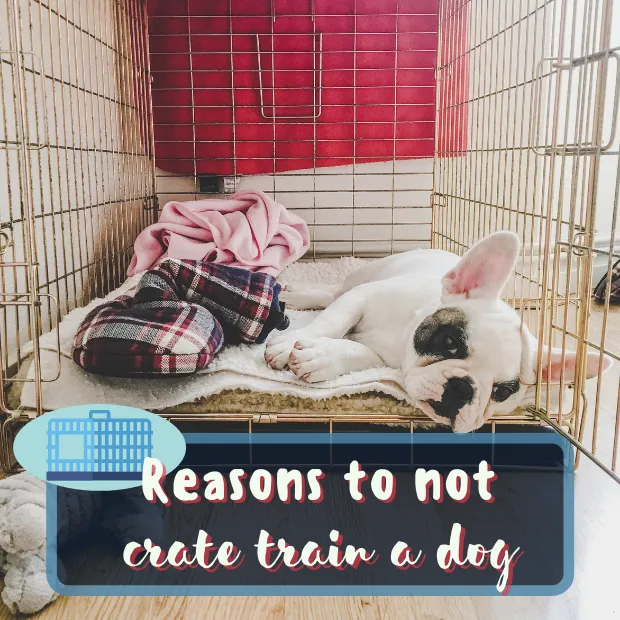There are a number of reasons to not crate train a dog which will vary from person to person. Maybe they think it’s cruel, or they’re worried their dog will be too anxious in a crate. Some people simply don’t have the time or patience to crate train their pet.
In this article we’ll answer some common questions about crate training and provide you with some great alternatives if you decide it’s not for you.
Table of Contents
ToggleContents of this article:
- I don’t want to crate train my puppy.
- Why put a dog in a crate?
- How do I stop my dog from freaking out in his crate?
- Is it OK to force a dog into a crate?
- Is crate training cruel? Will crate training traumatize my puppy?
- What if I don’t want to crate train my puppy?
- Alternatives to crate training.
- Conclusion – Reasons to not crate train a dog.
I don’t want to crate train my puppy.
Here are a few reasons you might not want to crate train your dog.
1. You think crates are cruel.
If you’re against the idea of confining your dog to a small space, then crate training isn’t for you. Some people view it as inhumane to keep their dog locked up, even if its just for short periods of time. If so, then crate training may not be the right choice for you.
2. You’re worried your dog will be anxious in the crate.
Another common concern is that crate training will make your dog anxious or stressed. While it is true that some dogs may find the experience of being in a crate stressful, this is not always the case. It is important to introduce your dog to their crate gradually and make sure they have plenty of positive experiences with it before using it for extended periods of time. If youre worried about your dogs anxiety, talk to your veterinarian or a professional trainer before starting crate training.
3. You don’t have the time or patience.
To do crate training properly takes time and patience, two things that not everyone has. If you’re short on time or don’t have the patience, then crate training may not be for you.
4. You have an older dog.
If you’ve never crate trained your dog before and they are already adults, they may not take to it easily. Older dogs are often set in their ways and may not be able to adjust to being confined to a small space. If you have an older dog, crate training may not be the best option.
5. You don’t have the room for a crate.
If you live in a small space or don’t have an extra room for a crate, then its understandable that you might not want to add one more thing to your home. If you don’t have the space for a crate, then crate training may not be right for you.
Crate training isn’t for everyone, but before deciding, it’s important to weigh up the pros and cons.
Why put a dog in a crate?
There are a few things to keep in mind if you’re considering not crate training your dog.
- First, some dogs can feel more secure in a small, enclosed space. This can be beneficial if you have a dog that is anxious or easily startled.
- A crate can also help prevent destructive behaviors like chewing or digging and prevent your dog from getting into mischief and hurting themselves when they are not supervised.
- Many owners find potty training their puppy is easier with the use of a crate.
- Utilising a crate can be a great management tool for behavioral issues such as resource guarding.
- It’s handy when holidaying with your dog as many accommodation providers will only allow dogs that are crate trained.
How do I stop my dog from freaking out in his crate?
There are a number of things you can do to make crate training less stressful for your dog.
First, make sure you introduce your dog to their crate gradually. Start by feeding them their meals in the crate and giving them treats while they’re in it. Once they’re comfortable with that, you can start closing the door for short periods of time with something to occupy them whilst they’re in the crate.
Make sure you let them out of the crate before they start to get anxious or stressed. If you can, try to leave them in the crate for longer periods of time as they get more comfortable with it.
You can also try to make the crate a more positive experience by adding blankets or toys and making sure it’s in a quiet, calm area of the house.
If you’re still having trouble, talk to a professional trainer for more help.
Is it OK to force a dog into a crate?
No, you should never force your dog into a crate. This will only make them more anxious and stressed and make the crate training process much harder.
Instead, introduce your dog to their crate gradually and make sure they have plenty of positive experiences with it before using it for extended periods of time.
Is crate training cruel? Will crate training traumatize my puppy?
No, crate training will not traumatize your puppy. If done correctly, crate training can be a positive experience for your puppy and help them feel more secure and comfortable in their environment.
What if I don’t want to crate train my puppy?
Crate training isn’t for everyone, but it can be a helpful tool for many dog owners.
If you decide not to crate train your puppy, make sure you have another plan in place to help them feel secure and comfortable in their environment and to keep them out of mischief when you can’t supervise them.
Alternatives to crate training.
Crate training takes time, effort and patience but can be very beneficial for both you and your dog. If you are not sold on crate training don’t worry, there are a few other options to consider.
1. Use an exercise pen for your puppy.
You could provide your dog with a designated space in your home that is their own, such as a puppy pen. This will allow them to have their own space to relax in, while still being able to see and interact with you and your family.
2. Dog-proof your home.
Make sure that any areas of your home that you do not want your dog to have access to are properly closed off or blocked off. This will help prevent them from getting into mischief and hurting themselves.
3. Keep your puppy tethered to you.
You can also keep your dog tethered to you with a short leash so they are always within reach. This is often called the umbilical cord method and can be very effective when potty training your puppy.
4. Hire a dog walker or pet sitter.
If you are not able to be home with your dog during the day, hiring a dog walker or pet sitter can be a good option. This will help to provide your dog with some company and exercise during the day.
5. Keep your puppy supervised at all times.
Another method you can use is to keep your puppy supervised at all times. This means that you will need to be with them whenever they are awake and alert.
6. Use stairgates to create a dog safe zone.
If you decide not to crate train your dog, there are some alternatives. You can use pet gates to block off areas of your home, such as the kitchen or laundry room. This will allow your dog access to certain areas while keeping them safe and out of trouble.
Reasons to not crate train a dog.
Crate training is a common method used by dog owners to help their dogs feel more comfortable in their environment.
If done correctly, crate training can be a positive experience for your dog. If you are not interested in crate training, there are a few other options to consider, such as using an exercise pen or dog-proofing your home.
Whichever method you choose, make sure that you are prepared to commit to it and that you have a plan in place to help your dog feel secure and comfortable.
Have a look at this related article if you want to know more about how to crate train your dog.







